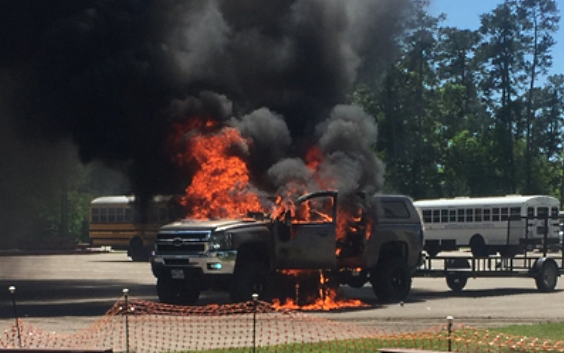

Plastic tubing, straps, and air hose rubber coatings.Hydrocarbon fluids such as diesel fuel, lubricating oil, bearing grease,….Plastic and polymer materials used as noise shields, insulation, flooring, trim, etc.Wiring insulation (normally has an ignition temperature about 150 oC).Well-oxygenated fires in materials that have low ignition temperatures spread quickly while fires in, for example, wheel bearing housings are usually slow to propagate. The rate at which a fire spreads also depends on these factors. There is a propagation path for the fire.There is an adequate supply of oxygen (air).Some (combustible) material is heated to its ignition temperature.It is also advisable to carry a fire extinguisher and to open circuit the batteries using an isolation switch when the vehicle is parked.įire takes hold under the following three conditions:.Exhaust clearance to combustible materials should exceed 150mm.


Anticipate whether a failed fitting could spray the fluid onto the exhaust pipe. Keep fittings in hoses that carry oil or fuel well away from the exhaust.Ensure that that fuel hoses are clamped at the ends and properly fixed. Check for rubs on the fuel lines and on the turbo charger oil line.Use compressed air to blow residue out of alternators and starter motors.Don’t add heavy electrical loads onto existing electrical circuits.Check and adjust the wheel bearings regularly.Keep combustible parts, such as noise shields and fibreglass engine tunnels, well away from the turbo and exhaust.If the rubber insert come out, a sharp metal edge will cut into the loom. Avoid clamps that have a metal spine and a thin rubber insert. Insist on rubber-block clamps to hold main electrical cables in place.Use plastic conduit to protect electrical cables that has fire-retardant properties.Specify that the starter motor cable is double insulated, conduited and taped closed.Specify that vehicles have circuit breaker protection on the alternator, trailer feed and cabin power supplies from the batteries.There are a number of ways a truck operator can minimise these risks: Road debris that catches under vehicles and is combustible.Sometimes overheated brakes cause the bearing grease to catch fire. Wheel bearing failures resulting in bearing grease catching fire.Tyres catching fire because they are flat or poorly inflated or rubbing on hard surfaces.Collection of carbon dust/organic residue in alternators leading to short circuit.If the fuse rating is increased, the wiring may not be adequately protected. Addition of heavy add-on loads onto a circuit not intended for it.Electrical arcs at terminals or connectors resulting from hot terminals that cause insulation to melt and catch fire.Turbo charger failures that cause excessive temperatures in the exhaust.Lubrication oil line failures near to the exhaust.

Power utility truck catches fire driver#
This places fire behind causes like inappropriate speed, fatigue, driver error and accidents with no discernible cause, but fire is more prevalent a cause than mechanical failure, theft and contributory negligence. According to research, fire is the cause of truck accidents in nearly eight per cent of cases, today PowerTorque looks at the common causes of fires in trucks and trailers.


 0 kommentar(er)
0 kommentar(er)
